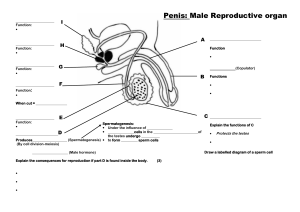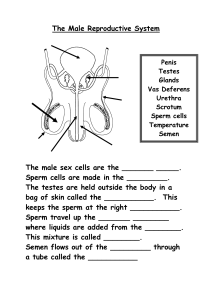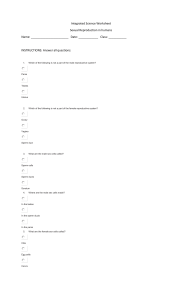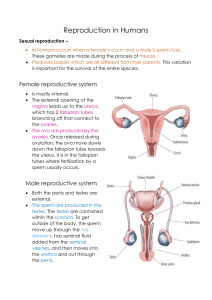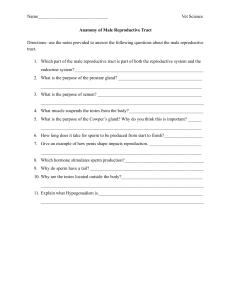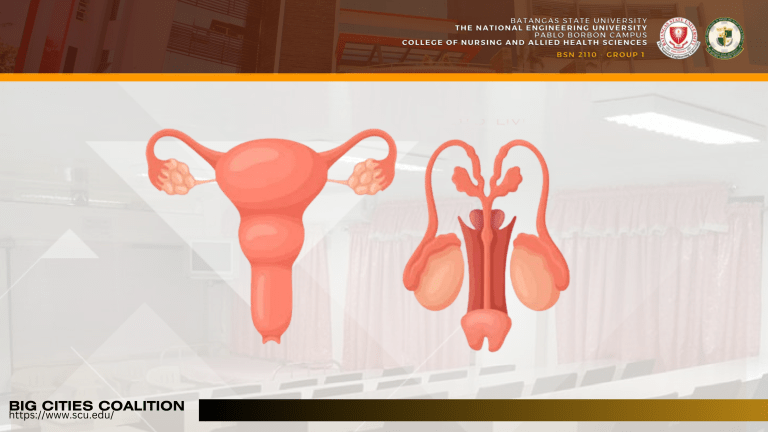
BIG CITIES COALITION https://www.scu.edu/ WHAT IS THE REPRODUCTIVE SYSTEM? a collection of internal and external organs — in both males and females — that work together for the purpose of procreating. FUNCTION OF THE REPRODUCTIVE SYSTEM? 1. Produce gametes 2. Secrete sex hormones 3. Nurture the developing fetus The major function of the reproductive system is to ensure survival of the species. STUDIES RELATED TO REPRODUCTIVE SYSTEM Andrology study of male reproductive organs Gynecology study of female reproductive organs Anatomy & Physiology MALE REPRODUCTIVE SYSTEM WHAT IS THE MALE REPRODUCTIVE SYSTEM? includes a group of organs that make up the reproductive system and urinary system in men and people assigned male at birth. consists of external and internal organs WHAT IS THE MALE REPRODUCTIVE SYSTEM? The external body parts of the male reproductive system include the penis, scrotum and testicles (also known as genitals). Internal (accessory) organs include vas deferens, ejaculatory duct, urethra, seminal vesicles, prostate gland, and bulbourethral (cowper) glands. FUNCTIONS OF THE MALE REPRODUCTIVE SYSTEM? To produce, maintain, and transport sperm and semen To discharge sperm within the female reproductive tract To produce and secrete male sex hormones HORMONES OF THE MALE REPRODUCTIVE SYSTEM Follicle-stimulating hormone (FSH) necessary to produce sperm (spermatogenesis). Luteinizing hormone (LH) necessary to continue the process of spermatogenesis. Testosterone the main sex hormone. It helps in developing certain characteristics such as muscle mass and strength, fat distribution, bone mass and sex drive (libido). EXTERNAL STRUCTURE MALE REPRODUCTIVE SYSTEM Structure The scrotum is a this that is located under the penis and is composed of skin and smooth muscle. The structures contained in the scrotal sac are the external spermatic fascia, testes, epididymis, and spermatic cord. SCROTUM Function responsible for protecting the testes. It helps with the thermoregulation of the testicles. It keeps the temperature of the testis several degrees below the average body temperature EXTERNAL STRUCTURE MALE REPRODUCTIVE SYSTEM Structure 2 small organs that are found inside the scrotum. TESTES Function responsible for making sperm producing a hormone called testosterone. EXTERNAL STRUCTURE MALE REPRODUCTIVE SYSTEM Structure The external reproductive organ of the male. The penis is made up of 2 parts, the shaft and the glans. PENIS Function urination and sexual intercourse. INTERNAL STRUCTURE MALE REPRODUCTIVE SYSTEM Structure EPIDIDYMIS Function The epididymis is a large coiled tube divided into the head, body and tail. 1. Head or caput epididymis – It stores the sperms until they are ready for maturation. 2. Body or corpus epididymis – It is the long coiled tube, where sperms mature. 3. Tail or cauda epididymis – It stores the mature sperm and is connected to the vas deferens. store the sperms for maturation and transport it to vas deferens. INTERNAL STRUCTURE MALE REPRODUCTIVE SYSTEM Structure Also known as the Ductus Deferens. The vas deferens is a long, muscular tube that travels from the epididymis into the pelvic cavity, just behind the urinary bladder. VANS DEFERENS Function transports mature sperm to the urethra in preparation for ejaculation. INTERNAL STRUCTURE SEMINAL VESICLES MALE REPRODUCTIVE SYSTEM Structure sac-like pouches that attach to the vas deferens near the base of the bladder. Function make up to 80% ejaculatory fluid, fructose. of your including INTERNAL STRUCTURE PROSTATE GLAND MALE REPRODUCTIVE SYSTEM Structure The prostate is a walnut-sized gland that rests below your bladder, in front of your rectum. Function secrete a thin, alkaline fluid which protects the sperm. INTERNAL STRUCTURE MALE REPRODUCTIVE SYSTEM Structure pea-sized structures on the sides of your urethra. BULBORETHRAL GLAND Function supply one more source of alkaline fluid for lubrication and neutralization. INTERNAL STRUCTURE MALE REPRODUCTIVE SYSTEM Semen, therefore, is derived from the prostate gland (60%), the seminal vesicles (30%), the epididymis (5%), and the bulbourethral glands (5%). TESTES AND ITS PROCESSES 1. Two ovoid glands, 2 to 3 cm wide, and rest in the scrotum. 2. It is commonly called as male gonads or testes. 3. Its main function is to produce and store sperm. 4. It synthesize two essential products: testosterone and sperm TESTES AND ITS PROCESSES 1. Each testes is encased by a protective white fibrous capsule and composed of a number of lobules. Each lobule contains interstitial cells (Leydig cells) that produce testosterone and a seminiferous tubule that produces spermatozoa. 2. Most males, one testis is slightly larger than the other and suspended slightly lower in the scrotum than the other( usually the left one). TESTES AND ITS LAYERS The testes are surrounded by several layers of tissue. They are the: Tunica Vasculosa first thin layer of blood vessels. a layer which shields the tubular interior of each testicle from further layers of tissue around the outer testicle. TESTES AND ITS LAYERS The testes are surrounded by several layers of tissue. They are the: Tunica Vasculosa first thin layer of blood vessels. a layer which shields the tubular interior of each testicle from further layers of tissue around the outer testicle. TESTES AND ITS LAYERS The testes are surrounded by several layers of tissue. They are the: Tunica Albuginea a thick, protective layer made of densely packed fibers that further protect the testes. TESTES AND ITS LAYERS The testes are surrounded by several layers of tissue. They are the: Tunica Vaginalis outermost layer of the tissue. the tunica vaginalis consists of three layers. TESTES AND ITS LAYERS The tunica vaginalis consists of three layers: Visceral layer. a layer which surrounds the tunica albuginea that shields the seminiferous tubules. Cavum vaginale. A layer which is an empty space between the visceral layer and the outermost layer of the tunica vaginalis. TESTES AND ITS LAYERS The tunica vaginalis consists of three layers: Parietal layer a layer that surrounds almost the entire testicular structure. HOW DOES TESTES MAKE SPERM? Seminiferous tubules coiled tubes that make up most of each testis. lined with a layer of tissue called the epithelium. It is made up of Sertoli cells that aid in the production of hormones that generate sperm. HOW DOES TESTES MAKE SPERM? Seminiferous tubules coiled tubes that make up most of each testis. lined with a layer of tissue called the epithelium. It is made up of Sertoli cells that aid in the production of hormones that generate sperm. HOW DOES TESTES MAKE SPERM? Rete Testis sperm cells travel toward the epididymis through the rete testis. rete testis helps to mix sperm cells around in the fluid secreted by Sertoli cells. The body reabsorbs this fluid as sperm cells travel from the seminiferous tubules to the epididymis. HOW DOES TESTES MAKE SPERM? Efferent ducts a series of tubes that join the rete testis to the epididymis. it is lined with hair-like projections called cilia. absorb most of the fluid that helps to move sperm cells. This results in a higher concentration of sperm in ejaculate fluid. HOW DOES TESTES MAKE SPERM? Rete Testis sperm cells travel toward the epididymis through the rete testis. rete testis helps to mix sperm cells around in the fluid secreted by Sertoli cells. The body reabsorbs this fluid as sperm cells travel from the seminiferous tubules to the epididymis. HOW DOES TESTES MAKE SPERM? Efferent ducts a series of tubes that join the rete testis to the epididymis. it is lined with hair-like projections called cilia. absorb most of the fluid that helps to move sperm cells. This results in a higher concentration of sperm in ejaculate fluid. ANATOMY OF THE PENIS Two chambers called the corpora cavernosa, which run the length of your penis and contain a maze of blood vessels shaped like a sponge. It has sponge-like spaces, which means blood can fill the open space. The urethra, or tube that carries pee and semen (the fluid containing sperm), which runs along the underside of the corpora cavernosa. ANATOMY OF THE PENIS Erectile tissue, two main arteries and several veins and nerves. The shaft, the longest part of your penis. The head (glans), which is at the end of the shaft. The meatus, or opening at the tip of the head where pee and semen come out. PENIS AND ITS PROCESSES Efferent ducts a series of tubes that join the rete testis to the epididymis. it is lined with hair-like projections called cilia. absorb most of the fluid that helps to move sperm cells. This results in a higher concentration of sperm in ejaculate fluid. PENIS AND ITS PROCESSES Three (3) cylindrical masses of erectile tissue: Corpora cavernosa the two cylindrical masses or erectile tissue form the dorsal portion and the side of the penis Corpus spongiosum smaller erectile masses occupies the ventral portion of the penis PENIS AND ITS PROCESSES Three (3) cylindrical masses of erectile tissue: Erection when a penis hardens and enlarges due to filling up with blood. Erections typically occur when a person with a penis is sexually aroused, but it can happen spontaneously. WHAT IS AN ERECTION? When your penis becomes hard and enlarged from an increase in blood flow. Go away after you ejaculate, but can also go away without ejaculating. HOW DOES AN ERECTION HAPPEN? Three (3) types of erections: Reflexogenic erections happen when something touches your genitals and triggers arousal. Psychogenic erections happen when you think of sexual memories or fantasies. This type of erection happens without physical touch. HOW DOES AN ERECTION HAPPEN? Nocturnal erections happen when you’re asleep. They occur more commonly during the deep stages of sleep. WHAT DOES EJACULATION MEANS? Ejaculation when you release semen (cum) from your penis. It usually happens when a person with a penis reaches orgasm (sexual climax), but it can also happen without orgasm. WHAT DOES EJACULATION MEANS? Ejaculation has two phases: emission and expulsion. Emission phase: In the first phase, sperm moves to your prostate from your testicles and mixes with fluid to create semen. Your vas deferens contract to squeeze the semen toward the base of your penis. Expulsion phase: In the second phase, muscles at the base of your penis contract every 0.8 seconds and force or shoot the semen out of your penis in several spurts. MAJOR REPRODUCTIVE HORMONES IN MALE MAJOR REPRODUCTIVE HORMONES IN MALE THE PROCESS OF SPERMATOGENESIS THE PROCESS OF SPERMATOGENESIS Sperm are made inside seminiferous tubules of the testes and become mature in the epididymis. Tubule is lined with spermatogonia (diploid cells that produce sperm). A diploid cell contains the usual number of chromosomes. Spermatogonia go through mitosis, produce diploid primary spermatocytes THE PROCESS OF SPERMATOGENESIS Primary spermatocytes go through first part of meiosis, produce haploid secondary spermatocytes. Haploid cells contain half the usual number of chromosomes. Secondary spermatocytes finish meiosis, form spermatids Spermatids move to epididymis, mature into sperm: grow a tail, lose extra cytoplasm in the head The tail allows the sperm to propel itself forward THE PROCESS OF SPERMATOGENESIS Sperm are released during ejaculation. The sperm are forced through the ducts and through the urethra. Mix with fluids from glands to form semen. Hundreds of millions of sperm are released with each ejaculation. SEXUAL DEVELOPMENT FOR MALES Three (3) Stages of Sexual Development: 1. Development before Birth 2. Puberty and its changes 3. Adolescent Growth

